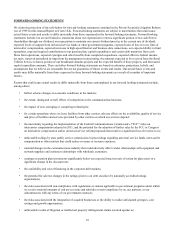Windstream 2012 Annual Report Download - page 70
Download and view the complete annual report
Please find page 70 of the 2012 Windstream annual report below. You can navigate through the pages in the report by either clicking on the pages listed below, or by using the keyword search tool below to find specific information within the annual report.
8
Business
The market for business customers is highly competitive. During 2012, business customers decreased by approximately 24,700
or 3.7 percent. Our growth in enterprise customers is outpaced by losses in small business customers, typically due to
competition from cable companies. However, our enterprise customers are driving growth in revenue through purchases of
integrated voice and data services, data center and managed services, and advanced data services such as multi-site networking.
Our primary competitors are other communications providers and cable television companies. In substantially all of our
business markets, we face competition from other communications carriers. They offer similar services, from traditional voice
to advanced data and technology services using similar facilities and technologies as we do, and compete directly with us for
customers of all sizes.
Cable television companies compete with us primarily for small or single-location businesses. Cable companies have deployed
technology to offer Internet services to their customers and offer competing voice and data services over the Internet
connection. In addition, their networks are capable of supporting wireless backhaul services.
To compete effectively in our business markets, we are investing in our network and service offerings to offer the most
technologically advanced solutions available. We rely on scalable, customizable solutions and a suite of services that allows us
to meet all of our business customers' communications needs.
Consumer
We experience intense competition for consumer services. During 2012, we lost approximately 86,000 consumer voice lines, or
4.5 percent of our total. Sources of competition in our consumer service areas include, but are not limited to, the following:
• Cable television companies: Cable television providers are aggressively offering high-speed Internet, voice and video
services in our service areas. These services are typically bundled and offered to our customers at competitive prices.
• Wireless carriers: Wireless providers primarily compete for voice services in our consumer markets. Consumers
continue to disconnect residential voice service in favor of wireless service. In addition, wireless companies continue
to expand their high-speed Internet offerings, which may result in more intense competition for our high-speed Internet
customers.
• Communications carriers: We are required to lease our facilities and capacity in our consumer areas to other
communications carriers. These companies compete with us by providing voice and high-speed Internet services to
consumers.
We are generally subject to more stringent regulation than our competitors in our consumer markets. For example, as a provider
of last resort, we are required to provide basic phone service to customers in our service areas regardless of whether it is cost-
effective to do so.
Although growth expectations are slowing due to the maturing market, we are committed to retaining customers by offering
faster broadband speeds and value-added services, while also offering the convenience of bundling those services with voice
and video services. During 2012, we added approximately 7,000 consumer high speed Internet customers, an increase of 0.6
percent, as compared to the prior year.
REGULATION
We are subject to regulatory oversight by the Federal Communications Commission ("FCC") for particular interstate matters
and state public utility commissions ("PUCs") for certain intrastate matters. We are also subject to various federal and state
statutes that direct such regulations. We actively monitor and participate in proceedings at the FCC and PUCs and engage
federal and state legislatures on matters of importance to us.
From time to time, federal and state legislation is introduced dealing with various matters that could affect our business. Most
proposed legislation of this type never becomes law. It is difficult to predict what kind of legislation, if any, may be introduced
and ultimately become law.
























